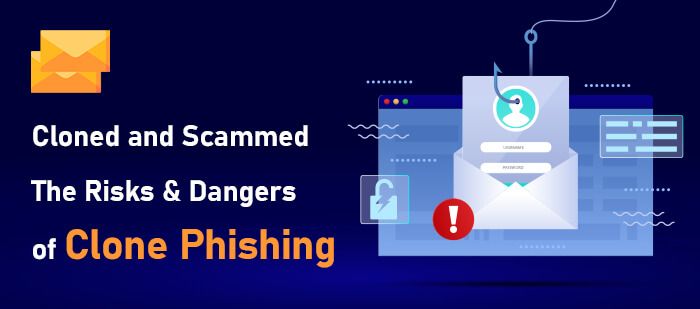
Clone Phishing is a form of cyberattack that is becoming increasingly common. This malicious form of attack involves the cloning of legitimate websites or emails in order to trick users into revealing sensitive information such as passwords, credit card numbers, or even personal documents. Unfortunately, this type of attack has become increasingly difficult to detect and can leave victims vulnerable to identity theft and financial fraud. In this blog post, we will discuss the risks and dangers associated with Clone Phishing and how to protect yourself from becoming a victim.
What is Clone Phishing?
Clone Phishing is a deceptive tactic used by cybercriminals to trick unsuspecting individuals into divulging their sensitive information. In this type of attack, hackers create fake websites or emails that closely resemble legitimate ones, making it difficult for users to distinguish between the real and fake. These clones often replicate well-known brands or popular services, making them appear trustworthy. Once a user interacts with the clone, they are prompted to enter their personal data, such as passwords or credit card numbers, which the hackers then capture for malicious purposes. Clone Phishing can be extremely dangerous as it targets individuals who trust reputable websites or emails, leaving them vulnerable to identity theft and financial loss. It is important to stay vigilant and learn how to protect ourselves from these deceitful attacks.
Some Related Blogs
- Top Causes of Fashion Chargebacks and How to Address Them
- The Price Matching Fraud Epidemic: Protect Your Business Now
- Hidden Costs of Chargebacks: How Much Really Costing You?
- 5 Tips for Fighting Travel & Hospitality Fraud with Chargebacks
How does Clone Phishing Work?
Clone Phishing works by capitalizing on the trust we have in reputable websites and emails. Cybercriminals create fake clones that closely resemble legitimate ones, making it difficult for us to spot the difference. They often imitate popular brands or services, luring us in with familiar designs and layouts. Once we interact with the clone, whether by clicking on a link or entering our information, we unknowingly hand over our sensitive data to the hackers. They then capture this information for their own malicious purposes, such as identity theft or financial fraud. It’s a deceitful and dangerous game that preys on our trust and leaves us vulnerable to devastating consequences. Understanding how Clone Phishing works is crucial in order to protect ourselves from falling victim to these cunning attacks.
Examples of Clone Phishing Attacks
Clone Phishing attacks can take many different forms, all designed to deceive unsuspecting individuals. One common example is when hackers create fake email messages that appear to be from a legitimate organization, such as a bank or an online retailer. These emails often ask the recipient to click on a link to update their account information or verify a recent transaction. Once the user clicks on the link and enters their personal information, the hackers have access to their sensitive data.
![]()
Email us anytime!
Email customer service 24/7
![]()
Call us anytime!
Reach customer care 24/7 at +1 (888) 901-8653
Another example is the creation of clone websites that mimic well-known online platforms, such as social media sites or online payment systems. These fake websites often have URLs that are very similar to the real ones, making it difficult for users to detect the scam. Once a user enters their login credentials or credit card information on these clone websites, the hackers can use this information for their own malicious purposes.
These are just a few examples of the many ways in which cybercriminals use Clone Phishing to trick unsuspecting individuals. It is important to stay vigilant and be cautious when interacting with emails or websites, especially those that ask for personal information. By being aware of these types of attacks and practicing good cybersecurity hygiene, we can protect ourselves from falling victim to Clone Phishing scams.
Why is Clone Phishing Dangerous?
Clone Phishing is an incredibly dangerous form of cyberattack that poses serious risks to individuals and organizations alike. The dangers lie in the fact that these clones are often difficult to detect, making it easy for unsuspecting users to fall victim to the scam. Once a user enters their personal information or financial details on a clone website or in a clone email, the hackers behind the attack can use this information for nefarious purposes such as identity theft and financial fraud. The consequences can be devastating, leading to financial loss, reputational damage, and even legal implications. Clone Phishing is dangerous because it preys on our trust in reputable sources and leaves us vulnerable to significant harm. It is crucial to be aware of the risks and take steps to protect ourselves from falling victim to these deceptive attacks.
Protecting Yourself Against Clone Phishing
To protect yourself against Clone Phishing, it’s crucial to be proactive and vigilant. First and foremost, always be skeptical of emails or websites asking for personal information. Remember, reputable organizations will never ask for sensitive data through email. Be cautious of clicking on links in emails, especially if they seem suspicious or out of the ordinary. Instead, manually enter the website URL in your browser to ensure you’re on the legitimate site. Additionally, it’s important to regularly update and strengthen your passwords. Use unique, complex passwords for each of your accounts and consider using a password manager to securely store them. Lastly, invest in robust cybersecurity software and keep it up to date. These measures can go a long way in protecting yourself from becoming a victim of Clone Phishing. Stay alert, stay informed, and stay safe.




